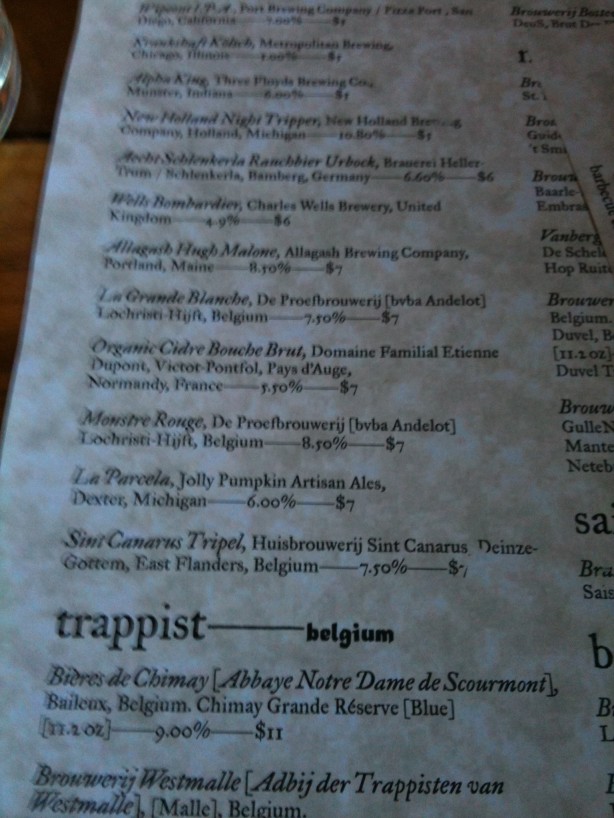In my short days of searching for my next favorite beer, I discovered about 3 years ago a flavor that can’t be mimicked. For a large portion of time I was having beer smuggled into Maryland for me from the Pennsylvania border. The distributor in Indiana couldn’t actually ship directly to Maryland due to the import laws for foreign beers in the state. Which, if you have an extended pallet, is a bit annoying. Horay, for encouraging the microbrew, bad if you want to taste anything that’s been trying to develop the perfect taste for the last 800 years.
In one of the random samples I once received from this beer house, I had this small stubby brown bottle from a brewery called Schlenkerla (the link is in german, so have fun if you follow it). Otherwise known as Brauerei Heller-Trum.

The glass was like drinking heaven. It was in all beers, the best thing I had ever had. It is seemingly dark and like many imports, it’s smooth. Now, I know all beers are described as smooth. As Scott’s father pointed out on a Sunday football game, “what beer has ever been described differently?” And, though we all may know what that means saying “smooth,” as we all have had a ‘Fail‘ Indian Pale Ale or the ‘Robust‘ unique flavor of a speciality beer, some things are not smooth. They are rough. They can be so overwelming in flavor, if you were forced to chug the beer in some sort of sick Beer Hell, you’d get one gulp in and the rest run out the side of your mouth. That’s not smooth. So when Coor’s Light describes it as ‘Smooth,’ they are right; it is. It’s water, of course it’s smooth. So saying smooth is not really always a compliment. When I say smooth, I mean, unlike a light water beer that you can just swallow, this has color and can easily be downed just due to its flavor and texture. It wants to go down.
And the beauty of most imports, especially non-microbrewers, are the general lack of preservatives. Many of the lagers coming out of Germany, especially bachs, are meant to age. Sulfates and other sodium preservatives just don’t exist, otherwise they may defeat the purpose. The result, you can ‘accidently’ drink your face off and not really feel horrible. A local micro-brew may not use Sulfates, but they are using something to preserve their beer. It’s like take-out Chinese, you may not use MSG, but you are using something. Salts and Sodium ruin beers, but that’s my opinion. And that’s what gives me such joy out of getting my hands on beers like a Bamberger.
There are just some flavors you can’t describe, if you can’t get your hands on it, do so. What makes the beer unique and why you can’t really mimick it easy, is something I can’t describe to you. This isn’t a beer that gets my thumbs up, or goes on my order again list. Oh no, this beer bottle went to the top of my shelf, as a memory of its flavor. I even went all the way to try and buy a speciality goblet from the brewer, but decided that that’s a gift best spent when I can get to the town itself. This isn’t an A list beer to me, this is my beer. Writing on it, makes me salavate.
The beer is a ‘Smoked Beer,’ specifically a Rauchbier (german for smoked beer). What makes the town of Bamberg special in Bavaria, Germany is that it’s brewers keep up a tradition of drying out the malt over a the beechwood fire. For whatever reason, that I have no idea why since I’m not a brewer, the beechwood smoked out drying process makes the most delicious flavor. And that’s what makes it so unique, that’s why it’s a Bamberger, not just a Ruchbier.
Due to its expense in the states, I generally can’t get my hands on this stuff. In my time, I’ve only really been able to try out about 3 Bambergers, all of which were amazing. It wasn’t until last week that we went out to a speciality Belgium style restaurant in Chicago, that my heart soared through the sky. Not only did they have one of the best import beer selections I had ever seen (other than the Hopleaf in the same city), they had the Aecht Schlenkerla Rauchbier on tap for $6 a goblet.

Just the upper right hand side of their beer list.
Now as my friend Scott can tell you, the food was over-priced, well-done, but overpriced small fancy proportioned wallet destroyers. The beer however, I could have stayed forever for. They wouldn’t let us stay past 7:30 though, so … we had about 4 rounds of tries and moved on. But for a short time, I got a beer on tap, I never thought I would see.

As a side note, old beers like Rauchbiers aren’t supposed to compressed and then carbonized through a tap as we know most ‘on draught beers.’ The proper way, is to literally tap the wood cask the beer is in and pour away. Now that right there, that is my goal. To Bamberg, home to my sweet, sweet pleasure… one day.




